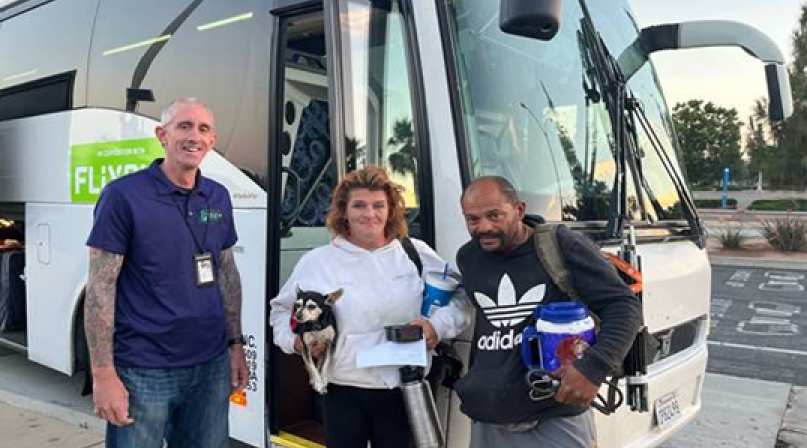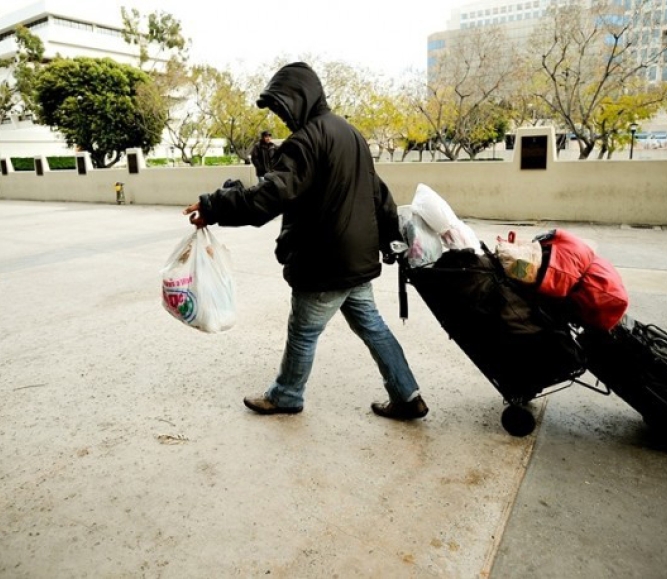Team approach, website help California county tackle homelessness

Key Takeaways
Riverside County, Calif. is bringing together staff across homelessness agencies and its county departments — including housing and workforce solutions, animal services and the parks and health systems — to better, and more efficiently, serve its unsheltered population in the Santa Ana River Bottom, which has the largest concentration of homeless encampments in the county.
The multidisciplinary team helps connect homeless individuals in the Santa Ana River Bottom to housing, mental health services, educational materials for fire management and suppression, veterinary services for pets and job placement. Riverside County used grant funding from the State of California Homeless Housing, Assistance and Prevention Grant Program to build the team and create a website to share stories of the people who have been helped, data collected through outreach and resources compiled for unhoused individuals in the area, such as where to access shelter, food, clothing and warming and cooling centers.
Learn more
“Before this whole collaborative, everything was siloed. ‘I do this thing, you do that,’ and it was all separate,” said Oscar Serrato, the natural resources manager for the Santa Ana River Collaborative, who oversees the park rangers’ role in the team. “… And it’s really transformed into something that I don’t think anybody really expected.”
The park rangers act as the “boots on the ground” of the team, identifying where and what the needs are of the unhoused population, while other groups — such as the Housing Authority, behavioral health staff and other homeless services organizations, including Path of Life Ministries — can work to get people the support they need instead of devoting time to that extra step of outreach, according to Serrato.
“For us, it’s ‘How can everyone be most efficient?’” Serrato said. “And the way it’s worked, [park rangers] are the ones on the ground. ‘Let’s shoot off a phone call to behavioral health, because this individual is looking for some sort of help through their services.’
“And I feel like that’s what really made the biggest impact — we’re able to see more people and help more people on a daily basis.”
The homeless outreach “heat map” on the Riverside County Santa Ana River Bottom Collaborative’s website, which is updated regularly by park ranger staff, acts as a way to track where there are higher concentrations of encampments and higher needs throughout the area, according to Serrato.
“Data is what makes this website really cool, that we can share all the great work — documenting every encampment in the river, and it has a heat map where we can show what areas need the most help,” Serrato said. “So, instead of us being out just searching for ‘Let’s see who needs help,’ we’re able to identify these hot spots to be more efficient all around, for us as ranger staff, but also to bridge those resources even faster than before.”
Since the creation of the website, agencies and nonprofits in the area have reached out to see how they can help support the team’s work, Serrato said.
“They’re like ‘How else can we help?’” Serrato said. “There’s a group — Healthcare in Action — they’re a bunch of physicians who literally just go out and they can assess on-site if somebody has some sort of injury or abscess, they can transport them to the hospital, they can take them to appointments. So, it has definitely grown in how far we’re reaching people by all these different agencies wanting to come on board.”
Not all of the unsheltered individuals in the Santa Ana River Bottom want support, but it’s the responsibility of park rangers to be there when they are ready to reach out for help, Serrato said.
In one of the testimonials shared on the collaborative’s website, an unhoused couple was living in the Santa Ana River Bottom after they experienced a death in the family that led to a property inheritance dispute, which resulted in them losing housing.
Bethany and Richard were repeatedly offered support by the team, but declined, until they had made plans to live with a relative in Ohio and needed help paying for bus tickets that would allow them to make the cross-country trek with their belongings, including a suitcase full of one of their Grandma’s china they had carried since moving out. Although the use was outside the limitations of the grant funding through the state, the team was able to leverage private funds to make it happen, according to Chris Oberg, CEO of Path of Life Ministries.
“We understand that everybody’s not ready to go that day, but we’re hoping that the day that they are ready, that we’re there being present,” Serrato said. “For them to see us every single day, it gives them that sensibility of, ‘They’re out here, we can trust them.’”
Establishing trust was the biggest obstacle park rangers faced with unsheltered individuals — their uniforms resemble those of law enforcement, Serrato pointed out — but the creation of the team has helped to remove that sense of skepticism, he said. Park rangers provide outreach throughout the Santa Ana River Bottom Monday through Friday from 7 a.m. to 3:30 p.m, according to Serrato. After about six months of offering consistent outreach, unsheltered individuals really began to open up and trust the team and its mission, Serrato said.
“We wanted them to know that we’re not here to arrest anybody, we’re not here to find them, we’re not here to do anything other than purely just help them in the most compassionate way possible,” Serrato said. “And we’ve been seeing such a difference in the way they speak to us. They’re telling us, ‘Hey, this is what happened last night,’ where before, we didn’t get any information. And I feel like it was important for us to kind of break that wall.”
Linda Sutton, a deaf woman from Riverside, was homeless for 14 years before she was connected to housing through the county’s Housing Authority. She initially lived in a tent in the Santa Ana River Bottom until her tent was stolen. She then couch-surfed before ending up back in the Santa Ana River Bottom, where she lived in her car before getting access to housing and supportive services through the outreach team.
“I love my apartment so much,” Sutton shared in the testimonial. “It’s so quiet here and people around here are friendly … I wanted to thank my workers for helping me and working hard for me. I will not forget that.”
In addition to sharing success stories, the website acts as a way for the team to document all of the collaborative meetings it has and its processes, so that other local governments or entities looking to adopt a similar system know where to start, Serrato said.
“I feel like we’ve created something with the collaborative that people can take somewhere else — in other cities, other states — and really be successful, and we want to share those things,” he said. “… So, that way people understand what it looks like and what it takes to get to where we’re at.”
Related News

U.S. Department of Health and Human Services announces major restructuring
On March 27, the U.S. Department of Health and Human Services (HHS) announced a sweeping reorganization that will consolidate agencies, shift key programs under a new framework and eliminate thousands of positions. This change brings HHS in line with President Trump's Executive Order, “Implementing the President’s ‘Department of Government Efficiency’ Workforce Optimization Initiative.”

Podcast: The CIO Reserves
Greenbrier County, W.Va. Commissioner Tammy Tincher, Cook County, Ill. CIO Tom Lynch and NACo CIO Rita Reynolds discuss the pilot CIO Reserves program, which offers IT experts to help rural counties assess their technology and cybersecurity needs.
County News
Ending homelessness takes slow and steady progress


